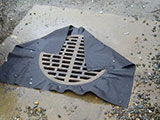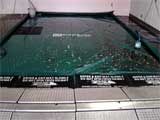BMPs are measures that eliminate, reduce, or mitigate outdoor exposed pollutant sources or pollutant discharges. BMPs may be physical devices (structural BMPs) such as storm drain filters or a roof over a waste storage area, or they can be behavioral (non-structural) measures, such as initiating a policy of sweeping up outdoor debris on a daily basis. Some typical BMPs are:
- Installation and maintenance of on-site storm drain protection equipment such as storm drain filter inserts.
- Keeping outdoor areas swept and clean.
- Covering or tarping oily, dirty items that must be stored outdoors.
- Moving waste oil storage indoors or placing it under permanent coverage.
- Providing coverage and secondary containment for stored fluids.
- Covering outdoor dumpsters, tallow bins, etc.
- Properly disposing of pressure washing discharges (see pressure washing).
- Cleaning spills promptly with dry methods (as opposed to hosing spills into a storm drain which is prohibited).
- Installing erosion control measures
- Stabilizing unpaved exit points with 1" or larger rock or paving to prevent track out of material.
Back to Storm Water Program main page
Pressure washing is an excellent way of removing pollutants from outdoor surfaces but pressure washing wastewater should never be discharged to a storm drain!
Storm drains should be temporarily covered, or the path to the drain should be blocked during pressure washing. With the property owner's permission, the collected wastewater can be pumped into a sanitary sewer clean-out, mop sink or toilet, or, in some instances, discharged to a landscaped area, provided that the discharge does not overflow the landscaped area, contain hazardous constituents, or create nuisance conditions. Sump pumps and wet/dry shop vacuums can be used to pump the wastewater.
Please refer to the  Sacramento Stormwater Quality Partnership – Preventing Stormwater Pollution: Best Management Practices (BMPs) For Pressure Washing And Surface Cleaning In The Greater Sacramento Area booklet for more details.
Sacramento Stormwater Quality Partnership – Preventing Stormwater Pollution: Best Management Practices (BMPs) For Pressure Washing And Surface Cleaning In The Greater Sacramento Area booklet for more details.
Back to Storm Water Program main page
 This storm drain is protected with filter fabric which can prevent coarser materials such as sand and sediment from passing through.
This storm drain is protected with filter fabric which can prevent coarser materials such as sand and sediment from passing through.
There are a wide variety of storm drain filters available ranging from fabrics which trap coarse sediment to drain inserts designed to filter out oils and other pollutants. These devices can offer an excellent ”last line of defense” but they should never be considered as stand alone, all purpose BMPs. No storm drain filter will catch all pollutants.
- Storm drain filters should be used in combination with other measures like regular sweeping, careful material and waste management, a prompt, well defined spill response policy, etc.
- You may not discharge prohibited substances to the storm drain just because you have a filter in place.
- Storm drain filters must be maintained to ensure effectiveness and prevent flooding.
Back to Storm Water Program main page
State and Federal regulations require local ordinances to prohibit unauthorized discharges to the storm drainage system and local water ways. One of the most common "prohibited discharges" is wastewater from commercial vehicle washing. While local ordinances do allow an individual to discharge vehicle wash water to the storm drainage system at his/her own home, businesses are prohibited from discharging wash water to the storm drainage system, local waterways, streets, or off-site areas.
Biodegradable Soaps
The manufacturers of many detergents and cleaning agents claim that their products are friendly to the environment. The truth is that even environmentally friendly products can be harmful to aquatic life and are not allowed to be discharged to the storm drainage system and local water ways. Even vehicle washing wastewater that contains no detergent typically contains brake dust residue, road grime, road tar, sediment, etc.
Compliance Alternatives
Portable drive on wash pad with sump pump.
 It is understood that businesses need to keep their vehicle inventories, fleet vehicles and customer’s cars clean. There are many ways of conducting vehicle washing without discharging the resulting wastewater to the storm drain. The following are some common compliance alternatives:
It is understood that businesses need to keep their vehicle inventories, fleet vehicles and customer’s cars clean. There are many ways of conducting vehicle washing without discharging the resulting wastewater to the storm drain. The following are some common compliance alternatives:
- Utilize a compliant car wash (compliant car washes are plumbed to the sanitary sewer).
- Temporarily cover storm drains in the vicinity of where vehicle washing is to be conducted with devices that form a leak-proof seal (see product information) on the drain opening. If properly sealed, vehicle wash wastewater will collect around the drain cover but will not run into the storm drain. The standing wastewater can then be collected with a wet/dry shop vacuum and poured, not pumped into a sanitary sewer clean-out, or into a toilet, or sink plumbed to the sanitary sewer or septic system.* Sweep or vacuum up remaining sediment and residue.
- Block the path from the washing area to nearby storm drains with a rubberized dyke (see product information), sand bags, or other devices and collect and handle the wastewater as described above (Note: Sand bags are heavy and can break open and spill out sand). Sweep or vacuum up remaining sediment and residue.
- Use a Boom system – This is a portable washing unit that captures wastewater with a long flexible boom that lays on the ground. The captured wastewater can then be poured into the sanitary sewer clean-out or pumped or dumped into a sink or septic system*, or serviceable sump.
- Use a portable wash pad that your vehicles can be driven onto. The pad will collect wastewater as it runs off the vehicle. A sump pump and garden hose can be used to pump the collected wastewater from the pad to the sanitary sewer through a sink with an air gap, or to a serviceable sump, or septic system*.
- Deionized water and other low volume washing systems, if used properly, can clean vehicles in place on a lot, without creating appreciable wastewater runoff. This is an acceptable compliance alternative if washwater is minimal enough to evaporate before it can runoff to the street, storm drain, etc. and detergents and other cleaners are not used that form a residue on the ground that will be washed into the storm drainage system when it rains. If cleaners are used, the resulting wastewater must be collected and properly disposed of as described in some of the other options.
- Construct and use a contained wash pad at your facility that is plumbed to sanitary sewer. This is more expensive than most of the other alternatives and may only make sense for businesses that wash a large number of vehicles.
- Self contained re-circulating wash systems are available that filter out sediment and other pollutants and continuously re-use the wash water (see product information). Filtered pollutants are periodically removed from the system and properly disposed of. This option may be especially useful to businesses located in areas not served by public sewer systems.
- Discharge vehicle washing wastewater to a landscaped area. In situations where only small numbers of vehicles are periodically washed, businesses have the option of washing the vehicles on a landscaped (lawn) or graveled area where wash water is allowed to infiltrate into the ground. The landscaped area must be able to contain and absorb all runoff and the discharge must not contain hazardous constituents or create nuisance conditions. For example, this activity must not result in dirt or mud track-out when vehicles are driven out of the landscaped area, and it must not result in harm to vegetation and/or chronic deposition of sediment, detergent residue, etc. in the landscaped area.
- Waterless vehicle cleaning systems (See product information)
* Caution must be exercised whenever discharging washwater on an ongoing basis to a septic system. Chemicals and excess volume may impact performance and/or result in overflow or damage to the system.
Note: It is not acceptable to install a filter into a storm drain for the purpose of discharging vehicle wash wastewater through it to the storm drainage system on an on-going basis.
Before discharging vehicle washing wastewater to the sanitary sewer please be sure to comply with the requirements of the local sanitary sewer agency.
Back to Storm Water Program main page
